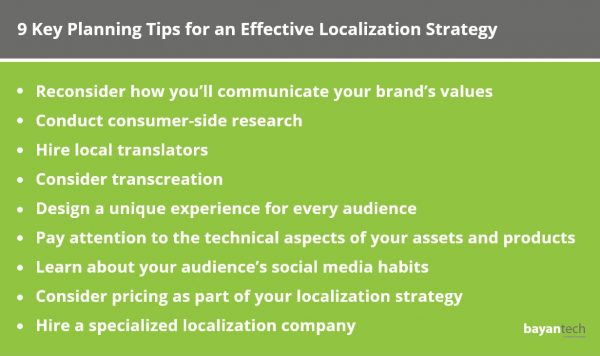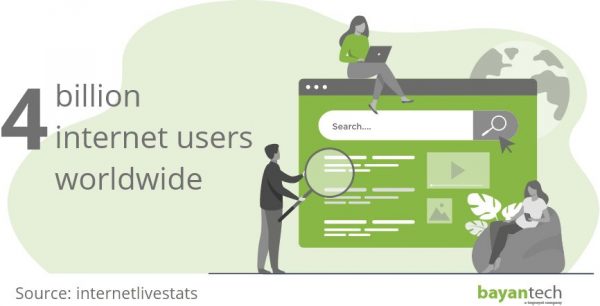If there is a word that resonates with ambitious business owners and entrepreneurs, it’s localization. If you’re in the planning stage for international expansion, you’ll need to consider the adaptation of your product, message, and brand assets to your target locale.
Localization is crucial to the international success of your brand. A properly executed localization strategy not only prevents you from sounding out of touch or out of place, but it also makes sure that you’re not breaking any local regulations.
Of course, not all localization strategies are created alike. You may have a localization strategy without seeing the results that localization is supposed to bring about. So, in this post, we’ll examine the key aspects of your brand or product that your business localization strategy should cover. Are there advantages and disadvantages of localization strategy in international business? How can we define a localization strategy?
Table of Contents

What is Localization?
Marketing translation is always perceived as the starting point for deploying a marketing strategy abroad. But this alone does not make for effective communication. Translating your brand content to another language is not enough to appeal to a global audience. Localization involves taking into account social and cultural preferences, as well as the idiosyncrasy and general worldview of the target culture, and adapting your brand so it can resonate with them. A successful localization process demands extensive research and attention to detail. So, it needs to be planned as far ahead as possible, rather than being left for the last minute.
Do You Need to Localize your Web Content?
A brand is hard to define. It’s not just your logo and your slogan. Your brand is in everything you do. A well-executed brand localization strategy guarantees that every element of your business that customers have contact with is targeted to them. This reveals the importance of localization in a long-term business strategy: it ensures that your product or service appeals to a foreign market more efficiently by creating a link between the brand and the public, tearing down cultural barriers for new customers. It also lays the ground for future expansion by getting the company used to engagement from a diverse client base and serving as an opportunity to consolidate best practices.
As explained before, if you want to appeal to a global audience, you need a localized marketing strategy, and this will involve digital marketing. Customers are more likely to buy your products if you approach them in their local language, and according to a CSA survey, in 2018, it took 31 languages to reach 97% of the global online market and in 2027, it’ll require 37… This makes a solid case for implementing website localization and creating a content localization strategy.

What is a Localization Strategy?
Each company has a different identity and builds that identity through different elements. Recognizing what these elements are and how they may result in cultural conflicts is essential. Localization Strategy consists of the planning and execution of the process of cultural, technological, and regulatory adaptation. By establishing a localization strategy, you ensure that your company has a well-defined expansion method and a long-term vision to support it.
As we pointed out, a localization strategy should be produced before starting a global expansion process. Doing it on the run can give you poor results, since the lack of previous cultural insight may lead to mistakes and offenses that will be extremely harmful to your brand.
Allocating enough time and resources will give you a competitive advantage, and the possibility of winning a considerable market share and increasing your returns. This makes a localization strategy highly cost-efficient. A study by Gartner found that businesses conducting marketing personalization can generate 20% more sales than their competitors. Adapting your approach to your new customers’ region is the first step in the right direction.

9 Key Planning Tips for an Effective Localization Strategy
When it comes to localization strategy pros and cons, the benefits of localization strategy far outweigh the only con, which is the investment that the process requires.
Actually executing a comprehensive and effective global localization strategy can be incredibly challenging for up-and-coming businesses. When you’re composing your localization strategy, remember to:

Reconsider How You’ll Communicate Your Brand’s Values
While it’s certain that each market embodies different values, it is no less true that your brand’s unique mission may rest on universal values.
Brand values are extremely important to make your brand memorable. And making a brand memorable isn’t as easy as you may think. A study by Prezi and neurologist Dr. Carmen Simon found that 80% of consumers will forget branded content within three days.
Having a message that goes beyond just your product allows you to create branded content that connects with customers on a deeper level. So, understanding what those values are and how to communicate them in a way that appeals to your new target customer could be your key to effective marketing and communication.
Three steps you can take for this purpose are:
- Researching with a local buyer persona in mind.
- Building a glossary of keywords that you will often use, as well as a style guide, to ensure eloquence and consistency across different marketing campaigns.
- Looking for local stories, events, and elements of pop culture that represent your values, and integrating them into your marketing, in a respectful and sensitive way.
Conduct Consumer-Side Research
- Where did your traffic come from?
- Which kinds of products are the most successful in each country?

Hire Local Translators
Many regions share the same language. For example, most Latin American countries have Spanish as their primary official language. The same occurs in the Middle East, with the Arabic language. But each country has its own dialects, linguistic differences, and nuances.
When building your localization strategy, it would be wise to hire native translators or a diverse language service provider. That way, you’ll avoid costly translation mistakes, while benefiting from insider insight into your target markets.
Consider Transcreation
While translating your content may be the most obvious first step when adapting your website, sometimes a wiser and more effective approach would be transcreating.
But, what is Marketing Transcreation? Some words, expressions, and messages may not be translatable or may seem underwhelming for your new audience. In these cases, you will find that elaborating new content or transforming some messages so they match new cultural codes is far more effective. This is called marketing transcreation. It’s a more sensitive and targeted approach when deploying a new marketing campaign abroad.

Deliver a Unique Experience to Every Audience
As we pointed out earlier, there are some essential aspects of your brand that you want to preserve at all costs. While it’s important to have universal values to appeal to a global audience, you will eventually need to face the cultural differences of your customers across the world. The key is to tinker around your brand’s voice and aesthetic values in those things that can be effectively localized. Here, the marketing translation team can focus on aspects like adapting the colors of your website and brochure or redefining the tone of the content to make it resonate with the audience of a certain country. Another important point is avoiding imagery and words that may cause controversy or rejection. Multimedia localization plays a major role if your company relies heavily on audiovisual content to communicate with its customer base.

Address Technological Differences
Reaching a global audience means that you will have to come into contact with an entirely different worldview, and a different way to go about everyday activities. Some countries may have connectivity issues, or their cultural habits may be reflected in the technologies they prefer or the way they use the internet. It is really important to take these technical aspects into account when defining your localization strategy.
For example, there are countries where most people navigate and buy through a mobile connection. According to Statista, Nigeria, Ghana, India, and Kenya are among the countries that registered the highest internet traffic coming from mobile devices.
Continuing with that example, we can mention that Nigeria, Ghana, India, and Kenya don’t have notably fast internet connections. So, in these cases, you should develop a Progressive Web App (PWA) that saves your users’ progress despite a slow or unstable connection.

Don’t Overlook Social Media & Search Engine Habits
Just like you need to know how your product will fit into the lives of your new customers, it’s also important to understand how they’re most likely to find out about you. Social media and search engine habits vary across locales.
Some countries are more prone to using certain social networks or platforms, so your localization strategy should involve becoming findable there. If your target demographic gravitates towards a search engine other than Google, your SEO strategy should unfold there. If your target demographic is particularly receptive to messages in a certain platform, create a profile that specifically targets them.
It’s also worth mentioning that even if your new customers prefer Google, you can’t just translate your existing keywords and call it a day. Conduct specific research into the local search habits and trends for your niche. Know what your competitors are doing both offline and online.
Localized Pricing?
A brand localization strategy goes far beyond marketing. You need to conduct a localization business strategy, adapting your operations to every new market. You should also take into account the economic situation of the average customer. What’s your average buyer’s purchasing power? How are your competitors pricing their products?
Many companies can achieve higher market penetration if they set up a localized pricing strategy. For example, digital gaming store Steam implemented a regional pricing system along with extended payment methods to encourage customers from developing countries to use the platform.
Sign up to our newsletter to receive the latest blogs and news.
How to Choose the Best Localization Team
Picking the right localization partner can make a huge difference when working to expand your company to new markets. But, what things do you need to pay attention to when making your choice?
First of all, it is crucial to have well-defined goals and needs. Find out if the provider can meet them. Are they interested in a long-term relationship? Building a long-lasting relationship with your audience will take a lot of time, so a shortsighted approach won’t be as effective as a well-planned localization strategy.
A localization strategy will involve everything from adapting cross-platform content to developing an SEO strategy, to making sure your product’s label isn’t unintentionally offensive. Make sure you hire the services of a company that stays on top of the latest technological developments and has best practices ingrained into their process. From using workflow automation and machine translation tools to implementing extensive Quality Assurance.
You should seek experienced partners, with a deep knowledge of your target cultures and a history of success helping other brands to grow. A competitive language partner could be the difference between a regular localization strategy and one that drives lasting growth for your organization.
This post examined the localization process and explained how it can drive growth for international businesses and how to design and implement an effective localization strategy.
Expanding your business beyond your home market has never been so easy. Depending on your industry, you may not even need a physical presence in your target country.










